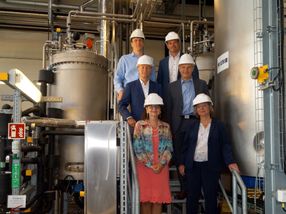Max Planck Innovation grants rights for developing new nanoscopic method to Leica Microsystems
Advertisement
Max Planck Innovation, the technology transfer organization of the Max Planck Society, grants Leica Microsystems, Wetzlar, an exclusive license for implementing the latest generation of optical microscopes with a resolution far below the diffraction limit (nanoscopes). This innovative optical nanoscopy, named GSDIM (ground state depletion microscopy followed by individual molecule return), achieves image resolutions in the nanometer range - even in conventional wide field microscopes. GSDIM was developed by Professor Stefan Hell, director at the Max Planck Institute for Biophysical chemistry in Göttingen, Germany, and his team.
True-to-detail imaging of the spatial arrangement of proteins and other biomolecules in cells and observing molecular processes - GSDIM makes this possible for researchers due to resolutions beyond the diffraction limit. The more insight science gains into these basic processes of life, the better it can find the causes of previously incurable diseases and develop suitable therapies.
One of the strengths of GSDIM is that it uses conventional fluorescence markers to image proteins or other biomolecules within the cells with sharpness down to a few nanometers. This includes fluorophores, which are routinely used in biomedical work, such as fluorescent proteins and rhodamines.
With GSDIM, the fluorescent molecules in the specimen are almost completely switched off using laser light. However, individual molecules spontaneously return to the fluorescent state, while their neighbours remain non-illuminating. In this way, the signals of individual molecules can be acquired sequentially using a highly sensitive camera system and their spatial position in the specimen can be measured and stored. An extremely high-resolution image can then be created from the position of many thousands of molecules. This enables cell components that are situated very close to one another and cannot be resolved using conventional wide field fluorescence microscopy to be spatially separated and sharply reproduced in an image.
Most read news
Topics
Organizations
Other news from the department research and development

Get the chemical industry in your inbox
By submitting this form you agree that LUMITOS AG will send you the newsletter(s) selected above by email. Your data will not be passed on to third parties. Your data will be stored and processed in accordance with our data protection regulations. LUMITOS may contact you by email for the purpose of advertising or market and opinion surveys. You can revoke your consent at any time without giving reasons to LUMITOS AG, Ernst-Augustin-Str. 2, 12489 Berlin, Germany or by e-mail at revoke@lumitos.com with effect for the future. In addition, each email contains a link to unsubscribe from the corresponding newsletter.































































